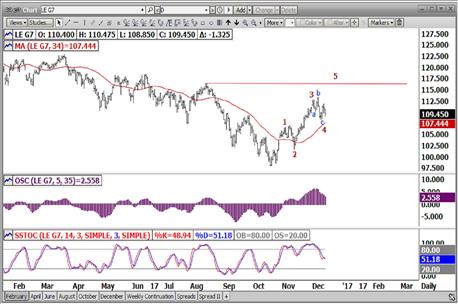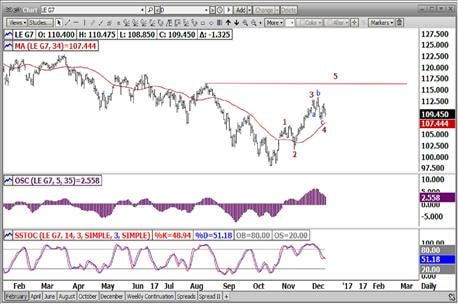
In my opinion, which should in no way be confused with fact, I perceive the harder bears attempt to push fat-cattle prices lower, the greater the demand it reflects.
After several weeks in a row of higher cash trading, the subtle changes are being seen by most. In order to slow the advance, I perceive packers to be pulling out all the stops from not buying cattle on the fat cattle exchange yesterday, to running futures lower. Vocalization of reduction in kills and Saturday kills has been another brow beating subject recently in print, as well.
I may be slightly over-optimistic, but no outside market forces appear to be negative toward beef or consumers.

The live cattle chart shows a waiting pattern with price either ready to move up again or fall below recent support.
I was encouraged this morning after having listened to a Bloomberg news service story on Chinese traders frothing the metals and other commodities markets. The nearly unprecedented movement of money from low-risk derivatives to higher-risk derivatives leads me to anticipate some of that money finding a home in commodities. Recall that this has only been three weeks of money movement that has been built up over an eight-year period of time.
While I do not anticipate beef to be the stalwart commodity leading all the rest out of the doldrums, I do anticipate it to not lag far behind.
The last time producers missed a week's sale, they were punished unmercifully. With
seemingly fewer overweight cattle coming into the mix, the bargaining table appears to be a little more on even ground than in the past, though.
I do not have the information to suggest holding out would be beneficial to producers. However, I will say that a $112.00 cash trade this week would be viewed more friendly towards the producer than packer.
Last week, I gave an analogy of the industry to produce a visual. Picture an hour glass, with the top bulb as the production of cattle from birth to packer. The packer is the neck line. The consumer, including wholesale and retail, is the bottom bulb.
I do not believe it to be terribly difficult to assess the herd size in the coming years if expansion continued to run wide open. The packing industry is perceived to have a fairly good indication of how large the herd can realistically grow and what facilities will be needed to process. At present, the packing industry appears content with a kill under 630,000. Even if the herd were to grow significantly, the idea of opening a new plant or refurbishing an old one doesn't appear to be on the top of their list.
Therefore, if correct, in order to offset the reduced kill capacity and potentially increase price per pound, the industry will either have to increase beef consumption, or reduce the kill weights of what is currently in the kill cycle.
Since outside market factors tend to dictate consumption, and remain beyond anyone's control, feedyards are urged to consider implementing some type of guide for those who retain ownership or even on the commercial side.
Again, I am fully aware that pounds are dollars. I also know that it is difficult to ascertain whether or not a reduced weight this past fall would have actually stalled or slowed the price decline. Regardless, I perceive the sooner it is recognized that the neck line of the hour glass is not going to expand anytime soon, that further work on the production side or at the consumer level will have to be done.
As for feeder cattle, there is little to discuss. I perceive they are on the coattails of the fats, so until fats resume their up move, feeders are anticipated to soften. At present, the current price action is not perceived as bearish.
An investment in futures contracts is speculative, involves a high degree of risk and is suitable only for persons who can assume the risk of loss in excess of their margin deposits. You should carefully consider whether futures trading is appropriate for you in light of your investment experience, trading objectives, financial resources and other relevant circumstances. Past performance is not necessarily indicative of future results.
About the Author(s)
You May Also Like




